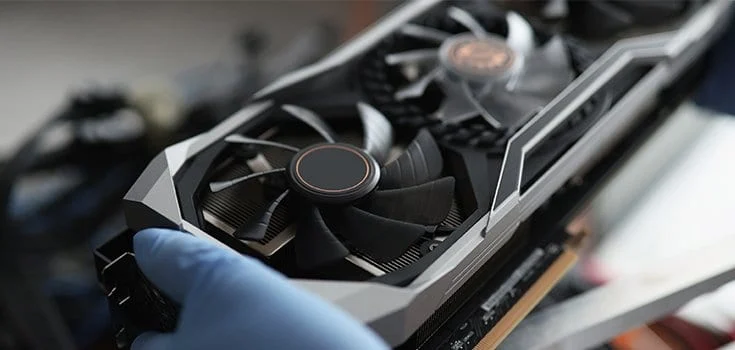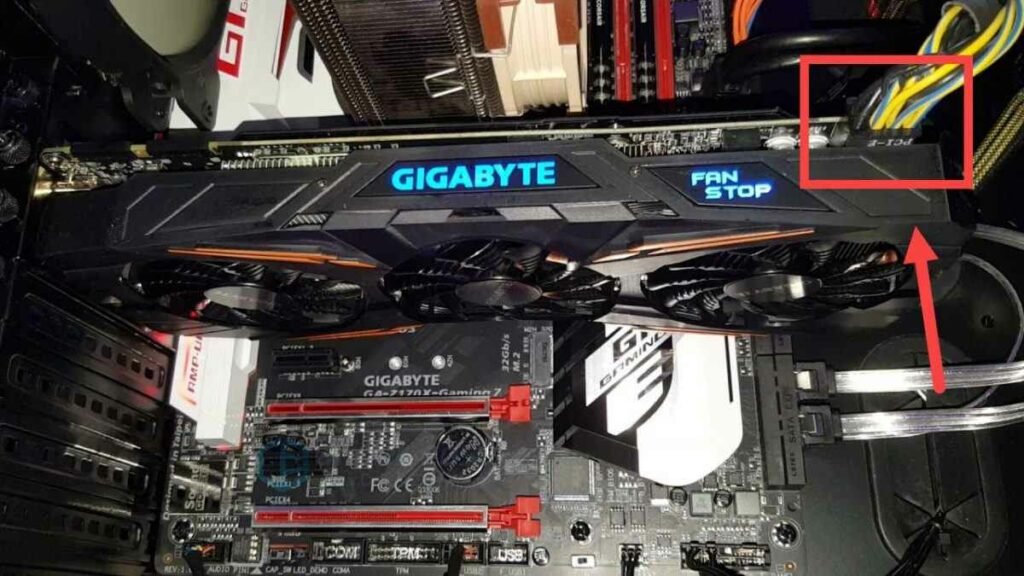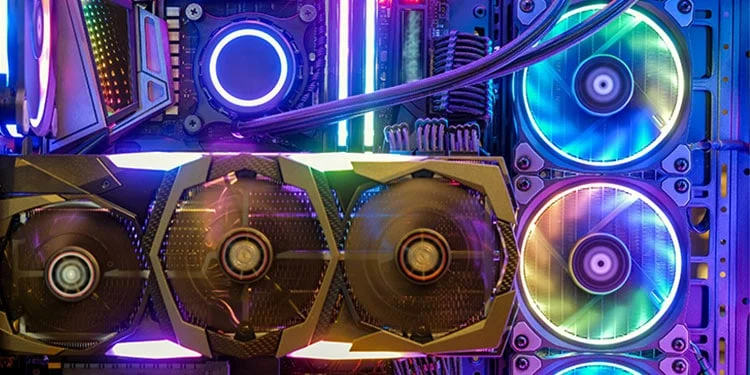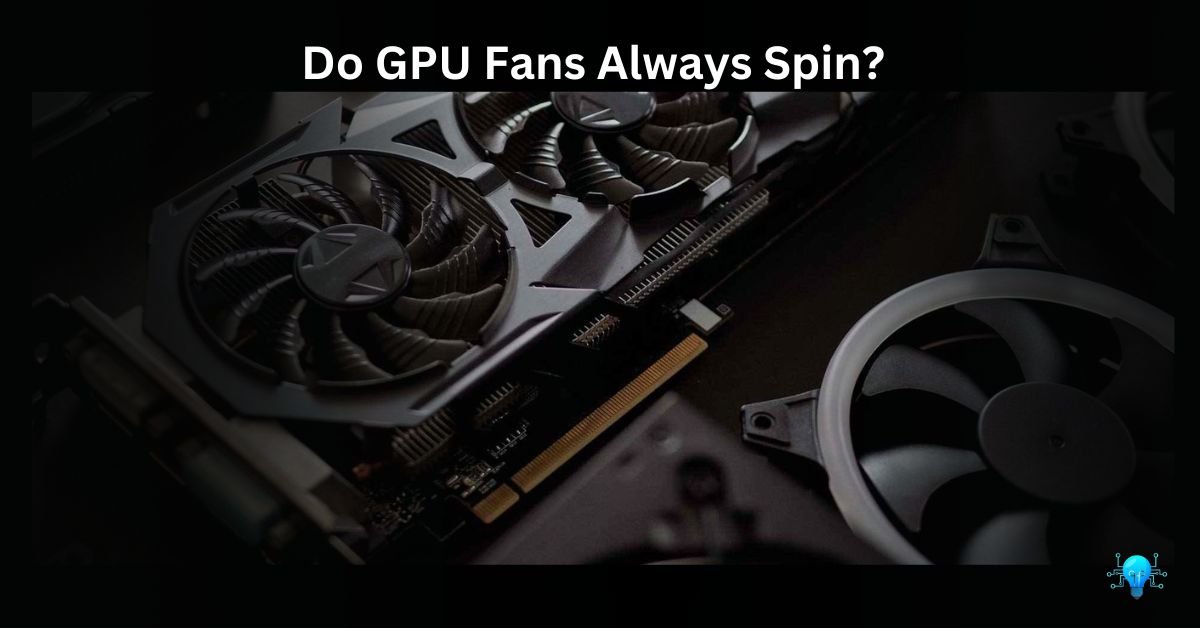Whether you’re battling enemies in your favourite game or tackling demanding graphics tasks, the behaviour of GPU fans can impact performance and system longevity.
No, GPU fans do not always spin. They typically spin up when the GPU reaches a certain temperature threshold to dissipate heat but may stop spinning during idle or low-load situations to reduce noise and save energy.
Let Me tell you more details about This factor we are going to discuss here in this article about GPU fans running!
What Is The Function Of A Fan In GPU? – You Have To Understand This First!
Before we delve into the details of GPU’s fan running, you have to understand its importance. The fan on a GPU plays a crucial role in keeping the graphics card cool while it’s running. As the GPU performs intensive tasks like gaming or rendering, it generates heat. The fan helps dissipate this heat by blowing air over the GPU’s heatsink, which draws heat away from the components and keeps temperatures within safe limits.
Without the fan, the GPU could overheat, leading to performance issues or even hardware damage. Therefore, the fan is essential for maintaining the optimal performance and longevity of the GPU.

How Can I Check If My GPU Fans Are Working Properly?
- Listen for consistent humming sounds from the GPU fans while your computer is running.
- Check visually for any obstructions or damage to the GPU fans, ensuring they spin freely.
- Use GPU monitoring software to check fan speeds and ensure they adjust according to GPU temperature.
- Perform a stress test on your GPU to monitor fan response under heavy load.
What Causes GPU Fans To Always Spin? – These 7 Things!
1. The Bios Driver Is Outdated:
An outdated BIOS driver can disrupt the communication between the GPU and the system, leading to an irregular fan proceeding. This can occur due to compatibility issues or lack of support for newer hardware configurations.
Have you explored? GPU Cache Folder – A User-Friendly Guide!
2. Overheated GPU:
When the GPU temperature exceeds safe limits, the GPU fans may start spinning continuously to dissipate heat and prevent damage to the graphics card. Overheating can occur due to heavy workload, inadequate cooling, or dust buildup.
3. Faulty GPU Fan:
A malfunctioning GPU fan can cause it to spin continuously regardless of the actual temperature of the graphics card. This can result from physical damage, wear and tear over time, or electrical issues within the fan mechanism.
Also Read: Are GPU Fans Intake Or Exhaust – Optimize Your PC’s Cooling!
4. You Haven’t Cleaned Your Case In A While:
Accumulated dust and debris inside the computer case can obstruct airflow and cause the GPU to overheat. In response, the GPU fans may start spinning continuously to compensate for the reduced cooling efficiency.
5. Hardware Issue:
Various hardware issues, such as faulty temperature sensors, damaged components, or inadequate power supply, can trigger abnormal fan working. These issues can disrupt the proper functioning of the GPU fans and lead to continuous spinning.
Take Analysis: Does GPU Brand Matter? – Make The Right Decision!
6. Software Issue:
Software glitches, driver conflicts, or compatibility issues can cause the GPU fans to malfunction and spin continuously. This can occur due to improper installation of drivers, conflicts between software applications, or bugs in the operating system.
7. Temperature Setting Issue:
Incorrect temperature settings or fan curve configurations in the GPU control software can cause the fans to spin continuously. This can occur if the temperature thresholds are set too low or if the fan speed settings are not optimized for the GPU workload.
You may be interested in reading: Is 53c GPU Temp Good – Let’s Find Out Together!
How Can We Fix the Spinning Problem of GPU Fan?
Is It Bad For GPU Fans to Always Spin, Yes it is! To fix GPU fan spinning issues, you can troubleshoot by updating drivers, cleaning the case for proper airflow, checking for hardware faults, and adjusting temperature settings in the software. Let me tell you the details of each problem!
First Of All, Fix The Outdated Bios Driver:
- Visit the manufacturer’s website and download the latest BIOS update for your GPU model.
- Install the updated BIOS driver following the manufacturer’s instructions.
- Ensure compatibility with newer hardware configurations to enhance communication between the GPU and the system, resolving irregular fan behaviour.

Cool Down Your GPU:
To keep your GPU from getting too hot, make sure to clean out any dust or dirt inside your computer regularly. You can also make it cooler by adding more fans or getting a better cooling system for your GPU. And when you’re using your computer for things like gaming or making videos, try not to push the GPU too hard to avoid making it too hot. By doing these things, you can help your GPU stay cool and work well for a long time.
Replace The Faulty GPU Fan:
- Consult a professional technician or contact the GPU manufacturer for warranty support if applicable.
- Repair or replace the malfunctioning fan to restore proper functionality to the GPU cooling system.
- Consider upgrading to a newer and more reliable GPU cooling solution to prevent future fan failures.
Cleaned Your Case In A While:
Regularly clean the case to remove any obstructions to airflow, including dust and debris. Use compressed air or a soft brush to gently remove dust from the GPU and its surrounding components. Install dust filters on case intake fans to prevent dust buildup and maintain optimal cooling performance.
Now, Fix The Hardware Issue:
Consult a professional technician for diagnosis and repair of faulty hardware components causing abnormal fan behaviour. Identify and replace any faulty hardware components, such as temperature sensors or damaged components, to restore proper functionality to the GPU cooling system. Also, Consider upgrading to newer and more reliable hardware components to prevent future issues.
Time To Resolve The GPU Software Issue!
- Update or reinstall GPU drivers and software to resolve driver conflicts or compatibility issues.
- Ensure that drivers are installed correctly and compatible with your GPU model and operating system.
- Use reliable GPU monitoring software to diagnose and troubleshoot any software-related issues affecting fan operation.
- I have tried MSI Afterburner, HWiNFO, GPU-Z, CAM by NZXT, and SpeedFan, which are set best in my case. Every software has its own specifications; you can use the one that will be best for your GPU!
Do The Perfect Temperature Setting:
The perfect temperature setting for a GPU can vary depending on factors such as the specific model of the GPU, the workload it’s handling, and personal preference.
However, as a general guideline, most GPUs operate optimally at temperatures between 60 to 80 degrees Celsius under load. It’s essential to ensure that temperatures stay below 80 degrees Celsius to prevent overheating and potential damage to the GPU. Check my guide on Is 80 Degrees Celsius Hot For A GPU? And set the right temperature for your system to run smoothly!
What Happens If My GPU Fans Stop Spinning?
If GPU fans stop spinning, it can lead to overheating, reduced performance, and potential damage to the graphics card due to inadequate cooling.
GPU fans play a crucial role in dissipating heat generated by the graphics card during operation. If the fans stop spinning, the GPU can quickly overheat, causing performance degradation and potential hardware damage. That’s Why It’s essential to address fan issues promptly to prevent overheating and maintain optimal GPU performance.
When Do GPU Fans Turn On? – Why do newer graphics card’s fans not spin until they reach a certain temperature?
GPU fans typically turn on when the GPU temperature reaches around 50-60 degrees Celsius to provide adequate cooling.
Newer graphics cards feature zero RPM fan technology, where fans remain idle until the GPU temperature surpasses a predefined threshold to reduce noise and energy consumption.
Traditionally, GPU fans activate when the GPU temperature surpasses a certain threshold, typically between 50-60 degrees Celsius, to provide cooling, As I‘ve discussed above. However, newer graphics cards incorporate zero RPM fan technology, where fans remain idle until the GPU temperature exceeds a predefined threshold. This approach reduces noise and energy consumption during light workloads or idle states, enhancing the user experience.

Is it normal for a GPU fan to spin very fast while gaming and return to normal while not gaming?
Yes, it’s normal for GPU fans to spin faster during gaming to dissipate heat generated by intensive tasks. They typically return to normal or idle speeds when the GPU is no longer under heavy load.
Let me shed light on backend logic; during gaming or other graphically demanding tasks, the GPU generates a significant amount of heat. To prevent overheating, the GPU fans automatically spin faster to increase airflow and cool the graphics card.
Once the workload decreases or the gaming session ends, the GPU temperature drops and the fans return to normal or idle speeds to conserve energy and reduce noise levels.
Take Analysis To: Gpu Junction Temperature 6700 Xt – Find Effective Solutions Here!
Should GPU fans be spinning while idle? – Are GPU Fans Always on!
It depends on the GPU model and manufacturer settings. Some GPUs feature zero RPM fan technology, where the fans remain idle or stop spinning while the GPU is at idle or low temperatures to reduce noise and energy consumption.
In modern GPUs, some models are equipped with zero RPM fan technology, which allows the fans to remain idle or stop spinning altogether when the GPU is at idle or low temperatures. This feature helps reduce noise levels and conserve energy when the GPU is not under load. However, other GPU models may have the fans spinning at a low speed, even during idle periods, to maintain minimal airflow and ensure consistent cooling. For further ideas, you can check this forum-based site so called Reddit and see whether GPU fans are supposed to spin always or not!
What should I do if graphics card fans turn on for a few seconds then stop?
Don’t Worry! If the graphics card fans turn on briefly and then stop, it may indicate that the GPU is not reaching a temperature threshold requiring active cooling. This behaviour is normal and occurs when the GPU temperature is within safe limits.
When the GPU temperature remains below a certain threshold, the graphics card fans may not need to spin continuously to maintain optimal cooling. Therefore, the fans may briefly turn on when the GPU starts up or during heavy workload but stop shortly after when the temperature stabilizes.
This behaviour is normal and ensures efficient cooling while minimizing noise levels and energy consumption. If the GPU fans continuously cycle on and off rapidly or exhibit other abnormal behaviour, it may indicate a malfunction or configuration issue that requires further investigation.
Frequently Asked Questions:
Is it normal for GPU fans to not spin?
Yes, some GPUs feature zero RPM fan technology, allowing fans to remain idle or stop spinning when the GPU is not under heavy load or at low temperatures.
Do RTX 3060 fans always spin?
No, RTX 3060 fans may utilize zero RPM fan technology, where fans remain idle or stop spinning to reduce noise and energy consumption during low GPU usage.
Should graphics card fans always spin?
Not necessarily. GPU fans may spin only when necessary to maintain optimal temperatures, utilizing zero RPM fan technology to reduce noise and energy consumption during idle or low GPU usage.
Can I Replace My Faulty GPU Fans?
Yes, faulty GPU fans can be replaced with compatible replacement parts, but it’s recommended to consult the GPU manufacturer or a professional technician for guidance.
Are There Any Risks Involved In Increasing The GPU Fan Speed?
Increasing GPU fan speed can improve cooling performance but may result in increased noise levels, higher power consumption, and premature wear on fan bearings.
Should GPU Fans Always Be ON?
Not necessarily. GPU fans may remain idle or stop spinning altogether during idle or low GPU usage to reduce noise and energy consumption.
Why do some graphics cards only have 1 fan?
Graphics cards with a single fan are often designed for smaller form factors or lower power consumption, providing sufficient cooling for less demanding tasks.
Do the fans face downwards towards the bottom of the case on all graphics cards?
No, the orientation of GPU fans varies depending on the graphics card model and design, with some facing downwards and others exhausting air out of the rear or top of the card.
Conclusion:
The speed of GPU fans varies depending on factors such as GPU model, manufacturer settings, and workload.
While some GPUs feature zero RPM fan technology, allowing fans to remain idle or stop spinning altogether during idle or low temperatures, others may spin continuously to provide active cooling.
Understanding the functionality of GPU fans and considering factors such as thermal performance, noise levels, and energy consumption is essential for optimizing GPU operation.

